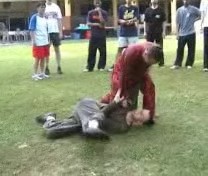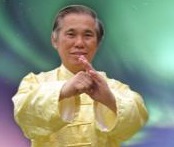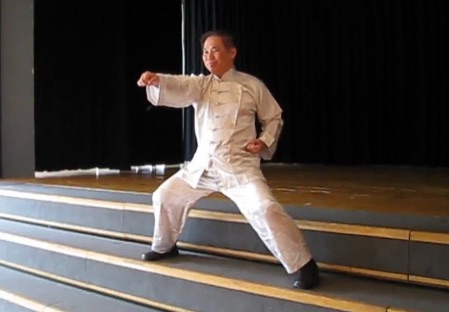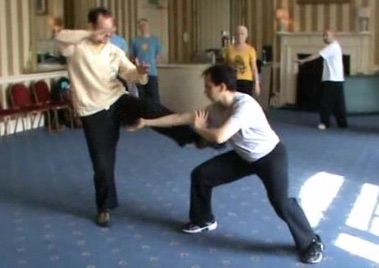SELECTION OF QUESTIONS AND ANSWERS
JUNE 2018 PART 3

An Intensive Shaolin Kungfu Course in Sungai Petani
Question 1
People learn kungfu for years. What can students learn at your Intensive Shaolin Kungfu Course? .
— Chen, Hong Kong
Answer
They can learn a lot, especially what they cannot learn elsewhere.
The two pillars of kungfu training are combat application and internal force training. By the end of the course, which only takes a few days, participants will be able to apply kungfu for combat, and have internal force. It is incredible but true.
Initially I offered the Intensive Shaolin Kungfu Course for instructors, so that they could teach genuine kungfu with combat application and internal force. However, not many instructors from other schools attended the Intensive Shaolin Kungfu Course. I give an offer, but if they do not want the offer, it is their right and their business. Most participants who attend the course now are from our school, Shaolin Wahnam.
There are three main reasons why instructors of other schools do not wish to attend the Intensive Shaolin Kungfu Course. They do not believe they can learn combat application using kungfu techniques, and develop internal force in just a few days of the course. They find the fee expensive. They are blindly loyal to their schools.
All those who attend the Intensive Shaolin Kungfu Course can use kungfu for combat and have internal force after a few days. Many course participants have told me that they are willing to pay many times the fee for the course. I have specifically said that participants need not mention that they learned the material of the course from Shaolin Wahnam. They can teach the material in their own schools if they find it useful.
Actually we practice kungfu, not just learn it. This was an invaluable lesson I learned from my sifu, Sifu Ho Fatt Nam, many years ago. The crucial difference between learning and practicing is that we learn new material, and we practice material we have learnt over and over again to become skillful. Hence, participants of the Intensive Shaolin Kungfu Course must practice the material they learned at the course.
"Kungfu" means Chinese martial art. Shaolin Kungfu is a style of kungfu. Taijiquan, Xingyiquan and Baguazhang are also kungfu styles. The word "quan" indicates that Taijiquan and Xingyiquan are kungfu. Shaolin Kungfu is called "Shaolinquan" in Chinese.
"Quan" literally means "fist", but figuratively means "kungfu". Baguazhang is so called because the palm, which is called "zhang" in Chinese, is used instead of the fist.
Besides the Intensive Shaolin Kungfu Course, I also offer the Intensive Taijiquan Course. Xingyiquan and Baguazhang are taught in regional courses.
Question 2
Is a Shaolin Warrior (maybe when he reaches a master's level) entitled to salute in a way that he or she likes -- within the limits of propriety and convention of course.
— John, Ireland
Answer
No, within the limits of propriety and convention, a monk even when he reaches a master's level, salutes or greets others according to the tradition of his lineage. The usual tradition of all lineages is to clasp both palms in front of the chest and bow, often mentioning "o mi tor fo".
Literally, "o mi tor fo" means Amitabha Buddha, but figuratively it means "Good morning", "Good day", "How do you do?" and the like.
Lay persons practicing kungfu will use the salutation or greeting pattern of their lineages or schools, especially at the start and the end of performing a kungfu set. At other times, they stand upright and place their left open palm and right close fist together at chest level, often not knowing its symbolism or that it is actually a Southern Shaolin greeting.
It is worthy to note that in this greeting, the elbows should be dropped, and the palm and fist are higher than the wrists. If the elbows are raised, the palm and the fist higher or at the same level as the wrists, chi would float up and the practitioner would become tired or panting for breath. If the palm and the fist face outward instead of sideway or downward, it is vulgar.
Non-kungfu persons may clasp the fingers of their open palm onto their close fist, irrespective of whether it is their right fingers on their left fist, or their left fingers on their right fist. This is a typical Chinese greeting, like one on New Year day.

Shaolin greeting
Question 3
With so many different types of training, my aim is Marvelous Fist, Golden Bell and One-Finger Shooting Zen. I have to be really careful not to over-train. For that reason sometimes it is only a couple of minutes of 30 punches and then some One-Finger Shooting Zen or Golden Bridge in the evening, and I still feel I am totally charged with energy.
— Karol. Norway
Answer
At your level and the way you practice -- like a few minutes of Marvelous Fist in the morning, and some One-Finger Shooting Zen or Golden Bridge in the evening -- you are unlikely to over-train. Although you spent only a few minutes in your training, because your training is correct and you are at a high-level, you feel charged with energy as well as other wonderful benefits not only during your training but the whole day and beyond.
I shall take this opportunity to mention about over-training. Over-training concerns depth, and not breath. For you it is not over-training. But for another person who is at a lower level but presuming he trains the same way as you do, it may be over-training for him.
It is unlikely he trains the same way as you because he is at a different level. Let us say he attains the same benefits. Although he trains at the same time-period, i.e. just a few minutes, the benefits he gets is more than what his body can bear.
It will be clearer if we quantify the benefits. Suppose his potential is 300,000 units of benefits. In other words, if he trains at 100%, he will get 300,000 units of benefits. But his body can take only 10,000 units of benefits. If he has more than 10,000 units of benefits, he over-trains. The more benefits he gets, the worse will be his over-training.
He trains at 30% of his potential. He gets 30,000 units of benefits. This is still over-training. He should train at less than 10% of his potential.
But how does he know he trains at 10% and not at 30%. The rule is that if he finds he has over-trained, he lowers his training time or intensity. If he finds that he still over-trains despite lowering his training percentage, he further lowers his training percentage. For example, when he trains at 30% he still finds symptoms of over-training, he lowers his training to 20%. If he finds that he still over-trains, he lowers it to 10%,
The good thing is that he has sufficient time to notice whether he trains at the right percentage if he is aware of over-training. In other words, if for a week he feels tired or painful despite training correctly, he lowers his training at 30% to 20%. If he still feels tired or painful, he further lower his training to 10%.
Different people will have different time for the symptoms of over-training before over-training becomes very harmful. But generally a month is manageable, and if he is aware of the risk of over-training, a month is long enough for him to make adjustment. If he is unaware of over-training, and especially he has the perverted concept of "no pain no gain", and keeps over-training, which means his training methods are right, not wrong, he will over-train seriously.
Needless to say, 10% and 30%, or 10,000 units of benefits and 30,000 units of benefits, are just figures for illustration. We can use any figure, and the underlying principles are the same. Different people may operate at different percentage, but 10% and 30% are suitable figures for our students.
It may not be easy for people to train at 10% of their potential, especially when most other people outside our school want to get the most from their training, whereas we tell our students to lower their benefits!
Many people earn 2,000 euros a month, but if they actually earn only 200 euros a month, which is 10%, it is insufficient for them to live normally. (People in Norway earn more, but their cost of living is also higher.) If you earn 200,000 euros a month, which is 100 times more than what many people earn, that is a lot of money for most people.
Now we change euros to units of benefits in chi kung training. If our students have 200,000 units of benefits whereas other students have only 2000 units, there are a lot of benefits.
Is it reasonable to estimate that if other students have 2000 units of benefits from their chi kung practice, our students have 200,000 units of benefits, or our benefits are 100 times more than those of others? Let us take the most crucial factor in chi kung training, i.e. chi flow -- a fact not often known in other schools, but often mentioned in our school.
Those who attend my courses have a chi flow on the very first day. If a student in another school can have a chi flow after 100 days, it is very good result. Most practitioners in other schools cannot willingly generate a chi flow at all regardless of how long they have practiced. Thus, it is reasonable to estimate that we are more than 100 times more efficient than other practitioners.
Your sifu too can enable you to have a chi flow in one day. But because you attend his regular class, he takes a longer time to teach you to generate a chi flow for your benefits.
Question 4
I enjoy more and more standing meditation and sitting-on-a-chair meditation I learned from Sigung during Summer Camp 2015. While in the past I wanted to achieve something, now I just relax and enjoy the breathing. The same is happening with my life.
Answer
There are four positions in meditation, namely standing, sitting, lying down and moving. By sitting meditation, we often mean sitting in a lotus position. Sitting on a chair is a modification.
The word "meditation" needs some explanation. It comes from the word "meditate", and implies thinking. But in some kinds of mediation, like the meditation in our school, there is no thinking, i.e. thinking rationally, though meditators may think intuitively, as in Cosmic Shower. But the term "meditation" is still used for those types of meditation without thinking, because the word has become established.
The term "meditation" was first used by our early Christian fathers who referred to thinking or reflecting on God's words. When other types of meditation came to the West, the term was also used. In our school, meditation refers to training of mind or spirit, which it actually is.
Generally, results come fast in standing standication. Sitting meditation is slow but the result is deep. Lying down meditation is for those who are old or too sick even to stand or sit. Moving meditation, like Taijiquan, is used when there is movement for training the mind or spirit. But because of our unbelievable skills, we can achieve in standing meditation what many people hope to achieve in sitting meditation.
Just being relaxed and enjoying the breathing is very important in chi kung and meditation, as well as in daily life. If a person is not relaxed, or is not enjoying his (or her) breathing, he cannot perform chi kung or meditation although he may be performing chi kung form or meditation positions.
Indeed, many practitioner today are in this category. They use chi kung forms or meditation positions, and think they are practicing chi kung or mediation. But they are not; they only perform the external forms but do not get the benefits of chi kung or of mediation.
In daily life, when a person is relaxed, he produces better result no matter what he does than when he is tensed. When he enjoys his breathing, he also produces better result than when he forces or holds his breathing.
In some chi kung exercises, a practitioner breathes spontaneously. Some people think, wrongly, that there is no breathing. There is breathing, but not forced or holding the breath, Spontaneous breathing is actually the most common mode of breathing in chi kung.

Shaolin Marvelous Fist
Question 5
How long should a typical student spend on "the basics", i.e. zhan zhuang, flexibility, footwork, body mechanics for shen fa, and fajing, and qigong skills like Entering Zen, smiling from the heart, and generating a qi flow?
— Frederick, USA
Answer
One year will be a good time to spend on the basics, i.e. zhan zhuang, flexibility, footwrodk, body mechanics for shen fa, fajing and qigong skills like entering Zen, smiling from the heart and generating a qi flow.
When I set up Shaolin Wahnam Association, the forerunner of our school Shaolin Wahnam Institute, I regarded the "basics" as what a kungfu practitioner should know. So my "basics" were quite extensive and in-depth, and included such areas as weapons and single unarmed against multiple armed.
There are 12 levels. A fast learner can complete each level in 3 months, taking 3 years to complete the "basics". An average student may need 5 years. You can see the "basics" in our Shaolin Kungfu Training Programme.
I divided the kungfu training programme into 3 stages. They were the practitioners' stage, the researcher's stage and the protector's stage, or in Chinese (Cantonese), "harng che", "chun sau", and "wu fatt". They corresponded to a bachelor's degree, a master's degree and a doctorate degree in university education.
After completing the "basics", which consisted of 12 levels and took between 3 to 5 years, a practitioner researched into a particular area of kungfu, like Baguazhang, tiger-claw and no-shadow kick. He would find out what past masters had done in his chosen area, what present masters are doing, and how he can enrich the area. This will take him about 3 years. After this, he became a protector of his chosen art, i.e. an authority.
This was my plan when I established Shaolin Wahnam Association. Because of expedient needs and some other reasons, I did not carry out the plan. Some years ago I offered an Advanced Combined Shaolin-Taijiquan Course to fill in the gaps in our syllabuses. But not as many instructors as I wished attednded the course.
Question 6
How much time should be spent for the practice of individual patterns to become competent at basic combat application (i.e. defending against characteristic hand attacks of the four directions, defending against basic kicks such as the side kick, thrust kick, organ seeking kick, and whirlwind kick)?
Answer
For the standard of present-day combatants, one year will be sufficient for our students. But he should spend this one year after a year of learning the basics you mentioned in Question 5, and another year to learn the skills and techniques of combat application. In other words, a student should start his training to fight competently against other combatants at the start of his third year.
Besides handling hand attacks, or strikes, and kicks, I would include felling and chin-na as well as common weapons and improvised weapons. The student should also have some training in handling multiple unarmed and armed attackers. One year, after he has trained the basic and other aspects of training, will be sufficient.
Free sparring and real fights do not come as individual patterns. They come as a sequence, regardless of whether the combatant realize it. In other words, a fighter does not attack you with one pattern, then retreats, and he moves in again with another attack of one pattern. He comes in with a series of attacks.
Our combat sequence training is a good answer to such series of attacks. Our method solves two major problems faced by many combatants, namely how to use kungfu techniques in combat, and how to respond correctly and spontaneously to opponents' attack. You will learn about this important aspect of combat in an Intensive Shaolin Kungfu Course.
To answer your question, to learn how to use individual patterns to counter strikes and kicks, as well as felling and chin-na will take only 15 minutes. How competent a student is to meet such attack will depend on his skills, and more significantly, on the actual use of his skills and techniques in free sparring or actual fighting. It is not uncommon that some students throw away their training, and bounce about like their opponents.

Sifu Tim and Frederick in Baguazhang combat at the UK Summer Camp
Question 7
When should I introduce formal combat sequence training and how much time do I spend on each combat sequence?
Answer
Combat sequence training is the core of combat application. It should be introduced after students have learnt the basis of entering Zen, stances, footwork, body-movement, regulating breadth, exploding force, and basic patterns, which is about 6 months after the start of their training. Indeed the two pillars of good kungfu are force training and combat application using combat sequences.
You should spend about a week on each combat sequence.
The combat sequences you learned at the UK Summer Camp Baguazhang Course are advanced. You may have to compose simpler combat sequences for your students.
Choose a simple theme, like handling common strikes. Compose a short sequence for this purpose. Ask your students to repeat this simple sequence many times in their training so that they can respond correctly and spontaneously to the common strikes.
Question 8
Should non-Baguazhang force and skills training that I've learnt in the past be taught, e.g. Two and One Finger Shooting Zen, Lifting Water, and Cosmos Palm?
Answer
If you intend to teach Baguzhang as your specialty, these non-Baguazhang force and skill training methods should be taught as a bonus, and not in your main syllabus.
There are many methods of force and skill training in Baguazhang. Circle Waling is a must. It trains footwork and agility.
Baguazhang stance training is an excellent way to build internal force. Students remain at one stance, like Single Changing Palm, for some time before moving to another stance.
Knowing non-Baguazhang training methods will of course enhance your Baguazhang in particular, and your kungfu in general.
LINKS
Selected Reading
- Over-Training and How to Deal with It
- My Direct Experience of Dim Mak
- Meaning of Classical Five Animals in Shaolin Kungfu
- How would the 108-Pattern Set Enrich our Daily Life
- Arches in the Snow
